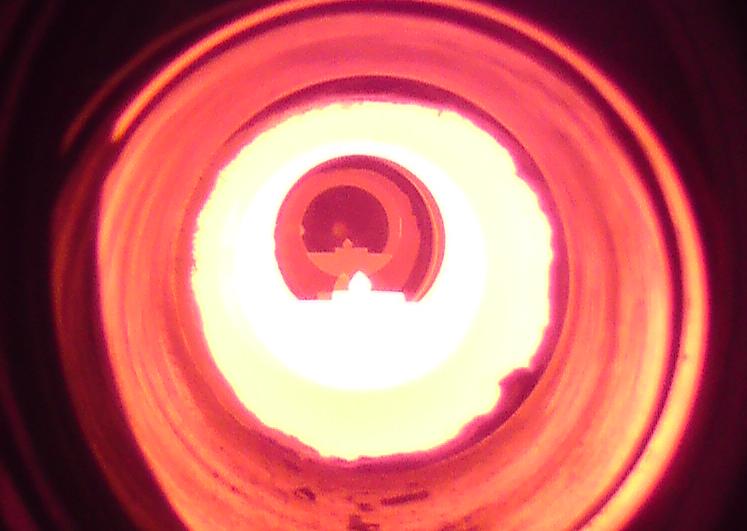Thermo-Optical Measuring method (TOM) could save several million tons of CO2 in coal-fired plants

Image shows inside of furnace while heating up brown coal rest slag at 1100 °C. Source: Fraunhofer ISC
On account of the energy turn and the turn away from the nuclear energy, alternative energy sources win more and more in meaning. However, the electricity supply cannot be provided by these energy sources only, the customary energy sources on fossil base come to the fore again. Mineral oil, natural gas as well as coal count to it basically. Unfortunately, due to CO2 emission they are much more detrimental to the environment and humans.
With the Paris agreement on the reduction of climate change by the end of 2015, 195 states decided to push forward the international climate protection and to reduce the global greenhouse gas emissions drastically. The global warming should not be higher than 2 °C, better yet 1.5 °C above pre-industrial level. Coal-fired plants have a high CO2 emission and show great impact on the environment and the climate. In many projects, Dr. Andreas Diegeler, head of CeDeD, and his team were able to show an enormous reduction of CO2 emissions in coal-fired plants.
In order to optimize the process and to reduce CO2 emission the scientists had to characterize and analyze the combustion process and the combustion products. Also the handling and utilization of the waste materials, especially the waste slag, is one of the most important focus points due to the development of new technologies.
For this purpose CeDeD used the Thermo-Optical Measuring method (TOM), a development of Fraunhofer ISC that optimizes the heat treatment of materials. The TOM's procedures are used with the cooperation partners in the area of combustion process and their optimization within capability to measure the combustion products in situ and their reaction with co-products (additive gases). Additionally, the characterization of slag assessment and fuel processes gets to win knowledge about the running off process and their optimization possibilities in the lab graduation.
TOM is designed for in situ characterization of materials within each kind of heat treatment under variable conditions. Main part of the measuring system is a furnace which can be equipped with different heating insets, depending on which test material, which surrounding atmosphere and at which temperature the investigations should be carried out.
The system can be driven under controlled atmosphere from room temperature up to extremely high temperature of 2400 °C. To be able to evaluate the behavior of the coal, openings which are equipped with view windows are right on both sides of the furnace along a horizontal axis. Besides, the left view window is used as an illumination opening, the right view window as an observation window.
On the side of the observation window a CMOS camera with special optics and filters is positioned. On the left side a strong source of light, a LED-Array with 100W and 3000 lm, illuminates the inner area of the furnace along the optical axis. The test material, coal e.g. will be placed in the optical axis in the center of the furnace. With this configuration the contour change of the test material during the heat treatment can be observed by picture analysis with a resolution up to 0.3 µm.
In addition an IR spectrometer or a gas chromatograph can be connected to the inner area of the furnace to detect the combustion gases. The system is able to control the atmosphere during the heat treatment. With this feature additive gases can join the combustion process. The influence and reaction will be observed in situ and simultaneously.
With this data the team of CeDeD could adapt and optimize the heating process to increase the efficiency and reduce the emission of undesirable gas products, respectively to minimize the CO2 emission.
In the case of lignite coal-fired power plant the furnace cleaning process was been optimized in the blast furnace by lowering the temperature and adding additive gases. With this improvement a reduction of CO2 emission of around 10% was achieved which leads to nearly 900 gram per kWh instead of around 1000 gram per kWh with a standard process.
To understand this progress we look to a modern lignite coal power plant with a capacity of 4 GW electrical power output. An amount of over 30 million tons of coal per year is needed to produce around 30 TWh electrical energy. This results in a CO2 reduction of 3 million tons per year.
The Centre for Device Development, called CeDeD, of Fraunhofer ISC is specified to transfer new developed measuring methods from the lab to industrial use. It works as a service provider for the whole institute, but also for external companies. TOM is used at the moment by several cooperation partners in the energy industry successfully.
Media Contact
All latest news from the category: Power and Electrical Engineering
This topic covers issues related to energy generation, conversion, transportation and consumption and how the industry is addressing the challenge of energy efficiency in general.
innovations-report provides in-depth and informative reports and articles on subjects ranging from wind energy, fuel cell technology, solar energy, geothermal energy, petroleum, gas, nuclear engineering, alternative energy and energy efficiency to fusion, hydrogen and superconductor technologies.
Newest articles

Innovative vortex beam technology
…unleashes ultra-secure, high-capacity data transmission. Scientists have developed a breakthrough optical technology that could dramatically enhance the capacity and security of data transmission (Fig. 1). By utilizing a new type…

Tiny dancers: Scientists synchronise bacterial motion
Researchers at TU Delft have discovered that E. coli bacteria can synchronise their movements, creating order in seemingly random biological systems. By trapping individual bacteria in micro-engineered circular cavities and…

Primary investigation on ram-rotor detonation engine
Detonation is a supersonic combustion wave, characterized by a shock wave driven by the energy release from closely coupled chemical reactions. It is a typical form of pressure gain combustion,…



